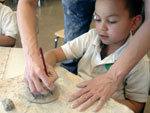
Researcher seeks novel biomaterials to regenerate tissues destroyed by periodontitis
INDIANAPOLIS - Indiana University School of Dentistry clinician-scientist Marco Bottino has begun a five-year project to develop novel biomaterials that will regenerate tissue destroyed by periodontitis and translate these materials to clinical practice.
Bottino’s research is funded by a $715,525 grant from the National Institute of Dental and Craniofacial Research of the National Institutes of Health.
An assistant professor in the Department of Restorative Dentistry's Division of Dental Biomaterials, Bottino is both a dentist and a materials scientist, positioning him to bridge the gap between biomaterials development and their application in patient care using nanotechnology, tissue engineering and clinical knowledge.
Periodontitis is one of the most aggressive chronic inflammatory oral diseases and a common oral health problem in adults. The disease causes gums to pull away from the teeth and form pockets that become infected. Bacterial toxins and the body's response to infection start to break down the bone and connective tissue that hold teeth in place. If left untreated, the bones, gums and connective tissue that support the teeth are destroyed, which in turn can lead to tooth loss. The occurrence of periodontitis increases among people over the age of 50.
“We are developing biomaterials to be placed into this periodontal defect that will regenerate bone and soft periodontal tissues at the same time,” Bottino said. “Currently, dentistry doesn’t have a single implantable biomaterial that can consistently guide the coordinated growth and development of multiple tissue types, especially in very large periodontal defects.”
To regenerate different kinds of tissues simultaneously, research will focus on coupling bioactive molecules with laboratory-made nanofibers, producing a multiple-layer, paper-like membrane that can be shaped and placed into the defect, Bottino said. After being placed, the membrane will degrade over time, releasing different kinds of molecules to promote and encourage the formation of hard (i.e., bony) and soft tissues destroyed by periodontitis.
“This project proposes not only to evaluate materials and cells at the bench level but to start clinical trials within three to five years,” Bottino said.
If the research is successful, it could lead to a treatment that would help patients retain teeth they might otherwise lose to periodontitis and avoid the need for dental implants or other restorative dental treatment, Bottino said. “We are mimicking what happens in nature, providing the body with the ingredients to make new tissues that hold teeth in place.”













